Asian elephant
The Asian elephant (Elephas maximus), also known as the Asiatic elephant, is the only living species of the genus Elephas and is distributed throughout the Indian subcontinent and Southeast Asia, from India in the west, Nepal in the north, Sumatra in the south, and to Borneo in the east. Three subspecies are recognised—E. m. maximus from Sri Lanka, E. m. indicus from mainland Asia and E. m. sumatranus from the island of Sumatra.[3]
| Asian elephant | |
|---|---|
.jpg) | |
| A tusked male Asian elephant in Bandipur National Park, Karnataka, India | |
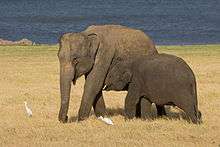 | |
| A female Asian elephant with calf in Minneriya National Park, Sri Lanka | |
| Scientific classification | |
| Kingdom: | Animalia |
| Phylum: | Chordata |
| Class: | Mammalia |
| Order: | Proboscidea |
| Family: | Elephantidae |
| Genus: | Elephas |
| Species: | E. maximus[3] |
| Binomial name | |
| Elephas maximus[3] | |
| Subspecies | |
|
E. m. maximus | |
 | |
| Asian elephant historical range (pink) and current range (red) | |
The Asian elephant is the largest living land animal in Asia.[4] Since 1986, the Asian elephant has been listed as Endangered on the IUCN Red List, as the population has declined by at least 50 percent over the last three elephant generations, which is about 60–75 years. It is primarily threatened by loss of habitat, habitat degradation, fragmentation and poaching.[2] In 2003, the wild population was estimated at between 41,410 and 52,345 individuals. Female captive elephants have lived beyond 60 years when kept in semi-natural surroundings, such as forest camps. In zoos, Asian elephants die at a much younger age; captive populations are declining due to a low birth and high death rate.[5]
The genus Elephas originated in Sub-Saharan Africa during the Pliocene and spread throughout Africa before expanding into the southern half of Asia.[1] The earliest indications of captive use of Asian elephants are engravings on seals of the Indus Valley Civilisation dated to the 3rd millennium BC.[6]
Taxonomy
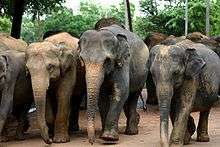
Elephas maximus was the scientific name proposed by Carl Linnaeus in 1758 who described the genus and an elephant from Ceylon.[7] Elephas indicus was proposed by Georges Cuvier in 1798, who described an elephant from India.[8] Elephas sumatranus was proposed by Coenraad Jacob Temminck in 1847 who described an elephant from Sumatra.[9] Frederick Nutter Chasen classified all three as subspecies of the Asian elephant in 1940.[10] These three subspecies are currently recognised as valid taxa.[2][4]
Elephas maximus borneensis was proposed by Paules Edward Pieris Deraniyagala in 1950 who described an elephant in an illustration published in the National Geographic magazine, but not a living elephant in accordance with the rules of the International Code of Zoological Nomenclature.[11][12] The Asian elephants living in northern Borneo are smaller than all the other subspecies, but with larger ears, a longer tail, and straight tusks. Results of genetic analysis indicate that their ancestors separated from the mainland population about 300,000 years ago.[13]
The following Asian elephants were proposed as extinct subspecies, but are now considered synonymous with the Indian elephant:[4]
- Syrian elephant (E. m. asurus), proposed by Deraniyagala in 1950, was based on Bronze Age illustrations.[11][14]
- Chinese elephant (E. m. rubridens), also proposed by Deraniyagala in 1950, was based on a bronze statuette of an elephant.[11]
- Javan elephant (E. m. sondaicus), also proposed by Deraniyagala in 1950, was an illustration of a carving on the Buddhist monument of Borobudur.[11][12]
Characteristics
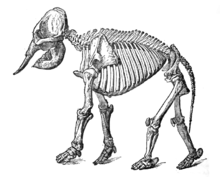
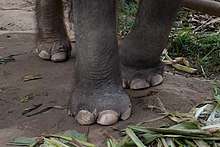
In general, the Asian elephant is smaller than the African bush elephant and has the highest body point on the head. The back is convex or level. The ears are small with dorsal borders folded laterally. It has up to 20 pairs of ribs and 34 caudal vertebrae. The feet have more nail-like structures than those of African elephants—five on each forefoot, and four on each hind foot.[4]
Size
On average, males are about 2.75 m (9.0 ft) tall at the shoulder and 4 t (4.4 short tons) in weight, while females are smaller at about 2.4 m (7.9 ft) at the shoulder and 2.7 t (3.0 short tons) in weight.[16][17][18] Length of body and head including trunk is 5.5–6.5 m (18–21 ft) with the tail being 1.2–1.5 m (3.9–4.9 ft) long.[4] The largest bull elephant ever recorded was shot by the Maharajah of Susang in the Garo Hills of Assam, India in 1924, it weighed an estimated 7 t (7.7 short tons), stood 3.43 m (11.3 ft) tall at the shoulder and was 8.06 m (26.4 ft) long from head to tail.[16][19][20] There are reports of larger individuals as tall as 3.7 m (12 ft).[15]
Trunk
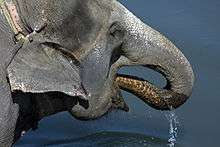
The distinctive trunk is an elongation of the nose and upper lip combined; the nostrils are at its tip, which has a one finger-like process. The trunk contains as many as 60,000 muscles, which consist of longitudinal and radiating sets. The longitudinals are mostly superficial and subdivided into anterior, lateral, and posterior. The deeper muscles are best seen as numerous distinct fasciculi in a cross-section of the trunk. The trunk is a multipurpose prehensile organ and highly sensitive, innervated by the maxillary division of the trigeminal nerve and by the facial nerve. The acute sense of smell uses both the trunk and Jacobson's organ. Elephants use their trunks for breathing, watering, feeding, touching, dusting, sound production and communication, washing, pinching, grasping, defence and offence.[4]
The "proboscis" or trunk consists wholly of muscular and membranous tissue, and is a tapering muscular structure of nearly circular cross-section extending proximally from attachment at the anterior nasal orifice, and ending distally in a tip or finger. The length may vary from 1.5 to 2 m (59 to 79 in) or longer depending on the species and age. Four basic muscle masses—the radial, the longitudinal and two oblique layers—and the size and attachments points of the tendon masses allow the shortening, extension, bending, and twisting movements accounting for the ability to hold, and manipulate loads of up to 300 kg (660 lb). Muscular and tendinous ability combined with nervous control allows extraordinary strength and agility movements of the trunk, such as sucking and spraying of water or dust and directed air flow blowing.[21]
The trunk can hold about four litres of water. Elephants will playfully wrestle with each other using their trunks, but generally use their trunks only for gesturing when fighting.[22]
Tusks
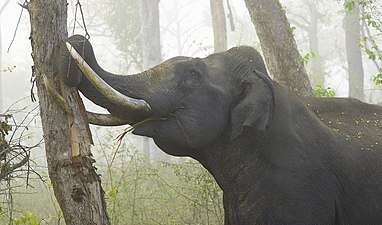
Tusks serve to dig for water, salt, and rocks, to debark and uproot trees, as levers for maneuvering fallen trees and branches, for work, for display, for marking trees, as weapon for offence and defence, as trunk-rests, and as protection for the trunk. Elephants are known to be right or left tusked.[4]
Female Asian elephants usually lack tusks; if tusks—in that case called "tushes"—are present, they are barely visible, and only seen when the mouth is open. The enamel plates of the molars are greater in number and closer together in Asian elephants. Some males may also lack tusks; these individuals are called "filsy makhnas", and are especially common among the Sri Lankan elephant population. Furthermore, the forehead has two hemispherical bulges, unlike the flat front of the African elephant. Unlike African elephants which rarely use their forefeet for anything other than digging or scraping soil, Asian elephants are more agile at using their feet in conjunction with the trunk for manipulating objects. They can sometimes be known for their violent behaviour.[23]
A record tusk described by George P. Sanderson measured 5 ft (1.5 m) along the curve, with a girth of 16 in (41 cm) at the point of emergence from the jaw, the weight being 104 1⁄2 lb (47.4 kg). This was from an elephant killed by Sir Brooke and measured 8 ft (2.4 m) in length, and nearly 17 in (43 cm) in circumference, and weighed 90 lb (41 kg). The tusk's weight was, however, exceeded by the weight of a shorter tusk of about 6 ft (1.8 m) in length which weighed 100 lb (45 kg).[15]
Skin
Skin colour is usually grey, and may be masked by soil because of dusting and wallowing. Their wrinkled skin is movable and contains many nerve centres. It is smoother than that of African elephants, and may be depigmented on the trunk, ears, or neck. The epidermis and dermis of the body average 18 mm (0.71 in) thick; skin on the dorsum is 30 mm (1.2 in) thick providing protection against bites, bumps, and adverse weather. Its folds increase surface area for heat dissipation. They can tolerate cold better than excessive heat. Skin temperature varies from 24 to 32.9 °C (75.2 to 91.2 °F). Body temperature averages 35.9 °C (96.6 °F).[4]
Intelligence
Asian elephants have a very large and highly developed neocortex, a trait also shared by humans, apes and certain dolphin species. They have a greater volume of cerebral cortex available for cognitive processing than all other existing land animals. Results of studies indicate that Asian elephants have cognitive abilities for tool use and tool-making similar to great apes.[24] They exhibit a wide variety of behaviours, including those associated with grief, learning, allomothering, mimicry, play, altruism, use of tools, compassion, cooperation, self-awareness, memory, and language. Elephants are reported to head to safer ground during natural disasters like tsunamis and earthquakes, although there have been no scientific records of this since it is hard to recreate or predict natural disasters.
Several students of elephant cognition and neuroanatomy are convinced that Asian elephants are highly intelligent and self-aware.[25][26][27] Others contest this view.[28][29]
Distribution and habitat
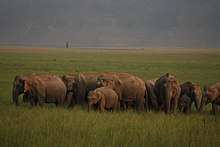
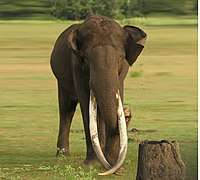
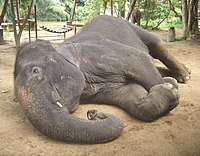
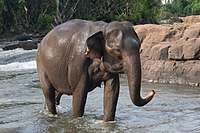
Asian elephants inhabit grasslands, tropical evergreen forests, semi-evergreen forests, moist deciduous forests, dry deciduous forests and dry thorn forests, in addition to cultivated and secondary forests and scrublands. Over this range of habitat types elephants occur from sea level to over 3,000 m (9,800 ft). In the eastern Himalaya in northeast India, they regularly move up above 3,000 m (9,800 ft) in summer at a few sites.[30]
In China, the Asian elephant survives only in the prefectures of Xishuangbanna, Simao, and Lincang of southern Yunnan.
In Bangladesh, some isolated populations survive in the south-east Chittagong Hills.[6] A herd of 20–25 wild elephants was reported as being present in the Garo Hills of Mymensingh in the late-1990s, being detached from a big herd in the Peack hills of India and prevented from returning by fences put up in the meantime by the Indian border security force. The herd was estimated at about 60 individuals in 2014.[31]
Three subspecies are recognised:[2][4]
- the Sri Lankan elephant occurs in Sri Lanka;
- the Indian elephant occurs in mainland Asia: Bangladesh, Bhutan, Cambodia, China, India, Laos, Malay Peninsula, Myanmar, Nepal, Thailand, Vietnam;
- the Sumatran elephant occurs in Sumatra.
The Borneo elephant occurs in Borneo's northern and northeastern parts.[32] In 2003, mitochondrial DNA analysis and microsatellite data indicated that the Borneo elephant population is derived from stock that originated in the region of the Sunda Islands. The genetic divergence of Borneo elephants warrants their recognition as a separate Evolutionarily Significant Unit.[33]
Ecology and behaviour
.jpg)
Elephants are crepuscular.[4] They are classified as megaherbivores and consume up to 150 kg (330 lb) of plant matter per day.[34] They are generalist feeders, and are both grazers and browsers. They are known to feed on at least 112 different plant species, most commonly of the order Malvales, as well as the legume, palm, sedge and true grass families.[35] They browse more in the dry season with bark constituting a major part of their diet in the cool part of that season.[36] They drink at least once a day and are never far from a permanent source of fresh water.[4] They need 80–200 litres of water a day and use even more for bathing. At times, they scrape the soil for clay or minerals.
Adult females and calves move about together as groups, while adult males disperse from their mothers upon reaching adolescence. Bull elephants are solitary or form temporary 'bachelor groups'.[37] Cow-calf units generally tend to be small, typically consisting of three adults (most likely related females) and their offspring.[38] Larger groups of as many as 15 adult females have also been recorded.[39] Seasonal aggregations of 17 individuals including calves and young adults have been observed in Sri Lanka's Uda Walawe National Park. Until recently, Asian elephants, like African elephants, were thought to be under the leadership of older adult females, or matriarchs. It is now recognized that females form extensive and very fluid social networks, with varying degrees of associations between individuals.[40] Social ties generally tend to be weaker than in African elephants.[39]
Elephants are able to distinguish low-amplitude sounds.[41] They can use infrasound to communicate.[42]
Rarely, tigers have been recorded attacking and killing calves, especially if the calves become separated from their mothers, stranded from their herd, or orphaned. Adults are largely invulnerable to natural predation. There is a singular anecdotal case of a mother Asian elephant allegedly being killed alongside her calf; however, this account is contestable.[43][44] In 2011 and 2014, two instances were recorded of tigers successfully killing adult elephants; one by a single tiger in Jim Corbett National Park on a 20-year-old elephant, and another on a 28-year-old elephant in Kaziranga National Park further east, which was taken down and eaten by several tigers hunting cooperatively.[45]
Reproduction
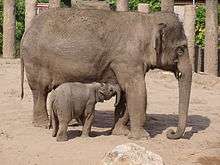
Bulls will fight one another to get access to oestrous females. Strong fights over access to females are extremely rare. Bulls reach sexual maturity around the age of 12–15. Between the age of 10 and 20 years, bulls undergo an annual phenomenon known as "musth". This is a period where the testosterone level is up to 100 times greater than non-musth periods, and they become aggressive. Secretions containing pheromones occur during this period, from the paired temporal glands located on the head between the lateral edge of the eye and the base of the ear.[46]
The gestation period is 18–22 months, and the female gives birth to one calf, only occasionally twins. The calf is fully developed by the 19th month, but stays in the womb to grow so that it can reach its mother to feed. At birth, the calf weighs about 100 kg (220 lb), and is suckled for up to three years. Once a female gives birth, she usually does not breed again until the first calf is weaned, resulting in a four to five-year birth interval. Females stay on with the herd, but mature males are chased away.[47]
Asiatic elephants reach adulthood at 17 years of age in both sexes.[48] Elephants' life expectancy has been exaggerated in the past. They live on average for 60 years in the wild and 80 in captivity.[4]
Generation length of the Asian elephant is 22 years.[49]
Females produce sex pheromones. A principal component thereof, (Z)-7-dodecen-1-yl acetate, has also been found to be a sex pheromone in numerous species of insects.[50][51]
Threats
The pre-eminent threats to the Asian elephant today are the loss, degradation and fragmentation of its habitat, which leads to increasing conflicts between humans and elephants. Asian elephants are poached for ivory and a variety of other products including meat and leather.[2] The demand for elephant skin has risen due to it being an increasingly-common ingredient in traditional Chinese medicine.
Human–elephant conflict
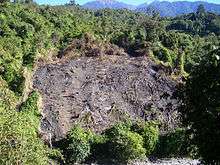
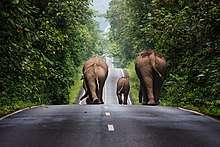
One of the major instigators of human–wildlife conflict in general is competition for space. This is especially true for wild Asian elephants, which require relatively large territories to live in. Destruction of forests through logging, encroachment, slash-and-burn, shifting cultivation, and monoculture tree plantations are major threats to the survival of elephants. Human–elephant conflicts occur when elephants raid crops of shifting cultivators in fields, which are scattered over a large area interspersed with forests. Depredation in human settlements is another major area of human–elephant conflict occurring in small forest pockets, encroachments into elephant habitat, and on elephant migration routes.[52] However, studies in Sri Lanka indicate that traditional slash-and-burn agriculture may create optimal habitat for elephants by creating a mosaic of successional-stage vegetation. Populations inhabiting small habitat fragments are much more liable to come into conflict with humans.[53]
Human-elephant conflict can be categorised into:[54]
- ultimate causes including growing human population, large-scale development projects and poor top-down governance;
- proximate causes including habitat loss due to deforestation, disruption of elephant migratory routes, expansion of agriculture and illegal encroachment into protected areas.
Development such as border fencing along the India-Bangladesh border has become a major impediment to the free movement of elephants.[55] In Assam, more than 1,150 humans and 370 elephants died as a result of human-elephant conflict between 1980 and 2003.[52] In India alone, over 400 people are killed by elephants every year, and 0.8 to 1 million hectares are damaged, affecting at least 500,000 families across the country.[56][57][58] Moreover, elephants are known to destroy crops worth up to US$2–3 million annually.[59] This has major impacts on the welfare and livelihoods of local communities, as well as the future conservation of this species.[54] In countries like Bangladesh and Sri Lanka, the Asian elephant is one of the most feared wild animals, even though they are less deadly than other local animals such as venomous snakes (which were estimated to claim more than 30 times more lives in Sri Lanka than elephants).[60][61] As a whole, Asian elephants display highly sophisticated and sometimes unpredictable behaviour. Most untamed elephants try to avoid humans, but if they are caught off guard by any perceived physical threat, including humans, they will likely charge. This is especially true of males in musth and of females with young. Gunfire and other similar methods of deterring, which are known to be effective against many kinds of wild animals including tigers, may or may not work with elephants, and can even worsen the situation. Elephants that have been abused by humans in the past often become "rogue elephants", which regularly attack people with no provocation.[62][63][64]
Poaching
For ivory
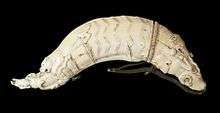
The demand for ivory during the 1970s and 1980s, particularly in East Asia, led to rampant poaching and the serious decline of elephants in both Africa and Asia. In Thailand, the illegal trade in live elephants and ivory still flourishes. Although the amount of ivory being openly sold has decreased substantially since 2001, Thailand still has one of the largest and most active black markets for ivory seen anywhere in the world. Tusks from Thai poached elephants also enter the market; between 1992 and 1997 at least 24 male elephants were killed for their tusks.[65]
Up to the early 1990s, Vietnamese ivory craftsmen used exclusively Asian elephant ivory from Vietnam and neighbouring Lao and Cambodia. Before 1990, there were few tourists and the low demand for worked ivory could be supplied by domestic elephants. Economic liberalisation and an increase in tourism raised both local and visitors' demands for worked ivory, which resulted in heavy poaching.[66]
For skin
The skin of the Asian elephant is used as an ingredient in Chinese medicine as well as in the manufacture of ornamental beads. The practice has been aided by China's State Forestry Administration (SFA), which has issued licences for the manufacture and sale of pharmaceutical products containing elephant skin, thereby making trading legal. In 2010, four skinned elephants were found in a forest in Myanmar; 26 elephants were killed by poachers in 2013 and 61 in 2016. According to the NGO Elephant Family, Myanmar is the main source of elephant skin, where a poaching crisis has developed rapidly since 2010.[67]
Handling methods
Young elephants are captured and illegally imported to Thailand from Myanmar for use in the tourism industry; calves are used mainly in amusement parks and are trained to perform various stunts for tourists.[65]
The calves are often subjected to a 'breaking in' process, which may involve being tied up, confined, starved, beaten and tortured; as a result, two-thirds may perish.[68] Handlers use a technique known as the training crush, in which "handlers use sleep-deprivation, hunger, and thirst to "break" the elephants' spirit and make them submissive to their owners"; moreover, handlers drive nails into the elephants' ears and feet.[69]
Disease
Conservation
The Asian elephant is listed on CITES Appendix I.[2] It is a quintessential flagship species, deployed to catalyze a range of conservation goals, including:
- habitat conservation at landscape scales[70][71]
- generating public awareness of conservation issues[54]
- mobilisation as a popular cultural icon both in India and the West.[70][71]
In captivity
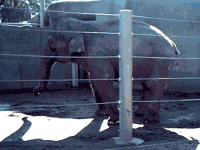
About half of the global zoo elephant population is kept in European zoos, where they have about half the median life span of conspecifics in protected populations in range countries. This discrepancy is clearest in Asian elephants: infant mortality is twice that seen in Burmese timber camps, and adult survivorship in zoos has not improved significantly in recent years. One risk factor for Asian zoo elephants is being moved between institutions, with early removal from the mother tending to have additional adverse effects. Another risk factor is being born into a zoo rather than being imported from the wild, with poor adult survivorship in zoo-born Asians apparently being conferred prenatally or in early infancy. Likely causes for compromised survivorship is stress and/or obesity.[72]
Demographic analysis of captive Asian elephants in North America indicates that the population is not self-sustaining. First year mortality is nearly 30 per cent, and fecundity is extremely low throughout the prime reproductive years.[73] Data from North American and European regional studbooks from 1962 to 2006 were analysed for deviation of the birth and juvenile death sex ratio. Of 349 captive calves born, 142 died prematurely. They died within one month of birth, major causes being stillbirth and infanticide by either the calf's mother or by one of the exhibition mates. The sex ratio of stillbirths in Europe was found to have a tendency for excess of males.[74]
In culture

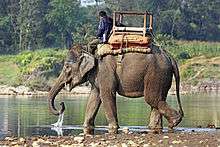
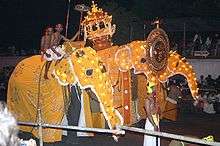
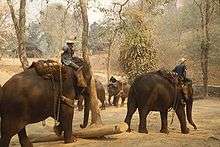
Bones of Asian elephants excavated at Mohenjo-daro in the Indus Valley indicate that they were tamed in the Indus Valley Civilization and used for work. Decorated elephants are also depicted on seals and were modelled in clay.[75]
The elephant became a siege engine, a mount in war, a status symbol, a beast of burden, and an elevated platform for hunting during historical times in South Asia.[76]
Elephants have been captured from the wild and tamed for use by humans. Their ability to work under instruction makes them particularly useful for carrying heavy objects. They have been used particularly for timber-carrying in jungle areas. Other than their work use, they have been used in war, in ceremonies, and for carriage. It is reported that war elephants are still in use by the Kachin Independence Army (KIA) to take control of Kachin State in northern Myanmar from Myanmar's military. The KIA use about four dozen elephants to carry supplies.[77]
The elephant plays an important part in the culture of the subcontinent and beyond, being featured prominently in the Panchatantra fables and the Buddhist Jataka tales. They play a major role in Hinduism: the god Ganesha's head is that of an elephant, and the "blessings" of a temple elephant are highly valued. Elephants are frequently used in processions where the animals are adorned with festive outfits.
The elephant is depicted in several Indian manuscripts and treatises. Notable amongst these is the Matanga Lila (elephant sport) of Nilakantha.[78] The manuscript Hastividyarnava is from Assam in northeast India.
In the Burmese, Thai and Sinhalese animal and planetary zodiac, the elephant, both tusked and tuskless, are the fourth and fifth animal zodiacs of the Burmese, the fourth animal zodiac of the Thai, and the second animal zodiac of the Sinhalese people of Sri Lanka.[79] Similarly, the elephant is the twelfth animal zodiac in the Dai animal zodiac of the Dai people in southern China.[80]
References
- Haynes, G. (1993). Mammoths, Mastodonts, and Elephants: Biology, Behavior and the Fossil Record. Cambridge University Press. ISBN 978-0521456913.
- Choudhury, A.; Lahiri Choudhury, D. K.; Desai, A.; Duckworth, J. W.; Easa, P. S.; Johnsingh, A. J. T.; Fernando, P.; Hedges, S.; Gunawardena, M.; Kurt, F.; Karanth, U; Lister, A.; Menon, V.; Riddle, H.; Rübel, A. & Wikramanayake, E. (IUCN SSC Asian Elephant Specialist Group) (2008). "Elephas maximus". IUCN Red List of Threatened Species. 2008: e.T7140A12828813.CS1 maint: multiple names: authors list (link)
- Shoshani, J. (2005). "Species Elephas maximus". In Wilson, D.E.; Reeder, D.M (eds.). Mammal Species of the World: A Taxonomic and Geographic Reference (3rd ed.). Johns Hopkins University Press. p. 90. ISBN 978-0-8018-8221-0. OCLC 62265494.
- Shoshani, J.; Eisenberg, J. F. (1982). "Elephas maximus" (PDF). Mammalian Species (182): 1–8. doi:10.2307/3504045. JSTOR 3504045.
- Sukumar, R. (2003). The Living Elephants: Evolutionary Ecology, Behavior, and Conservation. Oxford: Oxford University Press. p. 1. ISBN 978-0-19-510778-4.
- Sukumar, R. (1993). The Asian Elephant: Ecology and Management (Second ed.). Cambridge: Cambridge University Press. ISBN 978-0-521-43758-5.
- Linnaei, C. (1760). "Elephas maximus". Caroli Linnæi Systema naturæ per regna tria naturæ, secundum classes, ordines, genera, species, cum characteribus, differentiis, synonymis, locis. Tomus I. Halae Magdeburgicae: Ioannes Ioachimus Langius. p. 33.
- Cuvier, G. (1798). "Elephas indicus". Tableau elementaire de l'histoire naturelle des animaux. Paris: Baudouin. p. 148–149.
- Temminck, C. J. (1847). "Elephas sumatranus". Coup-d'oeil général sur les possessions néerlandaises dans l'Inde archipélagique. Tome second. Leide: A. Arnz and Comp. p. 91.
- Chasen, F.N. (1940). "A handlist of Malaysian mammals, a systematic list of the mammals of the Malay Peninsula, Sumatra, Borneo and Java, including the adjacent small islands" (PDF). Bulletin of the Raffles Museum. 15: 1–209.
- Deraniyagala, P.E.P. (1955). Some Extinct Elephants, Their Relatives and the Two Living Species. Colombo: Ceylon Natural History Museum.
- Cranbrook, E.; Payne, J. & Leh, C.M.U. (2007). "Origin of the elephants Elephas maximus L. of Borneo" (PDF). Sarawak Museum Journal. 63: 95–125.
- Fernando, P.; Vidya, T. N. C.; Payne, J.; Stuewe, M.; Davison, G.; Alfred, R. J.; Andau, P.; Bosi, E. & Kilbourn, A. (2003). "DNA Analysis Indicates That Asian Elephants Are Native to Borneo and Are Therefore a High Priority for Conservation". PLOS Biology. 1 (1): e6. doi:10.1371/journal.pbio.0000006. PMC 176546. PMID 12929206.
- Girdland Flink, E.L.; Albayrak, E. & Lister, A. (2018). "Genetic insight into an extinct population of Asian elephants (Elephas maximus) in the Near East" (PDF). Open Quaternary. 4 (1): 1–9. doi:10.5334/oq.36.
- Lydekker, R. (1894). The Royal Natural History. Volume 2. London: Frederick Warne and Co.
- Larramendi, A. (2016). "Shoulder height, body mass and shape of proboscideans". Acta Palaeontologica Polonica. 61 (3): 537–574. doi:10.4202/app.00136.2014.
- Sukumar, R.; Joshi, N.V.; Krishnamurthy, V. (1988). "Growth in the Asian elephant". Proceedings: Animal Sciences. 97 (6): 561–571. doi:10.1007/BF03179558.
- Kurt, F.; Kumarasinghe, J.C. (1998). "Remarks on body growth and phenotypes in Asian elephant Elephas maximus". Acta Theriologica. 5 (Supplement): 135–153. doi:10.4098/AT.arch.98-39.
- Pillai, N.G. (1941). "On the height and age of an elephant". Journal of the Bombay Natural History Society. 42: 927–928.
- Wood, Gerald (1983). The Guinness Book of Animal Facts and Feats. Enfield, Middlesex : Guinness Superlatives. ISBN 978-0-85112-235-9.
- Rasmussen, L. E. L. (2006) Chapter 32. Chemical, Tactile, and Taste Sensory Systems. In: Fowler, M. E., Mikota, S. K. Biology, medicine, and surgery of elephants. Wiley-Blackwell, Oxford, UK. ISBN 978-0-8138-0676-1. pp. 409 ff.
- Spinage, C. A. (1994). Elephants. London: T & A D Poyser. ISBN 978-0856610882.
- Clutton-Brock, J. (1987). A Natural History of Domesticated Mammals. London: British Museum (Natural History). p. 208. ISBN 978-0-521-34697-9.
- Hart, B.L.; Hart, L.A.; McCoy, M.; Sarath, C.R. (2001). "Cognitive behaviour in Asian elephants: use and modification of branches for fly switching". Animal Behaviour. 62 (5): 839–847. doi:10.1006/anbe.2001.1815. S2CID 53184282.
- Williamson, J. H. (1950). Elephant Bill. Doubleday.
- Aldous, P. (2006). "Elephants see themselves in the mirror". New Scientist.
- Poole, J. (1997). Elephants. World Life Library. ISBN 978-0896583573.
- Sanderson, G. P. (1879). Thirteen years among the wild beasts of India. London: W.H. Allen and Co. p. 80.
- Nissani, M. (2006). "Do Asian elephants apply causal reasoning to tool use tasks?". Journal of Experimental Psychology: Animal Behavior Processes. 31 (1): 91–96. doi:10.1037/0097-7403.32.1.91. PMID 16435969.
- Choudhury, A. U. (1999). "Status and Conservation of the Asian elephant Elephas maximus in north-eastern India". Mammal Review. 29 (3): 141–173. doi:10.1046/j.1365-2907.1999.00045.x.
- "Wild elephants a nightmare for Sherpur villagers | Dhaka Tribune". www.dhakatribune.com. Archived from the original on 23 June 2016. Retrieved 22 May 2016.
- Alfred, R.; Ahmad, A. H.; Payne, J.; William, C.; Ambu, L. (2010). "Density and population estimation of the Bornean elephants (Elephas maximus borneensis) in Sabah" (PDF). Online Journal of Biological Sciences. 10 (2): 92–102. doi:10.3844/ojbsci.2010.92.102.
- Fernando P.; Vidya T.N.C.; Payne J.; Stuewe M.; Davison G.; Alfred R.J.; Andau, P.; Bosi, E.; Kilbourn, A.; Melnick, D.J. (2003). "DNA Analysis indicates that Asian Elephants are native to Borneo and are therefore a High Priority for Conservation". PLOS Biol. 1 (1): e6. doi:10.1371/journal.pbio.0000006. PMC 176546. PMID 12929206.
- Samansiri, K. A. P.; Weerakoon, D. K. (2007). "Feeding Behaviour of Asian Elephants in the Northwestern Region of Sri Lanka" (PDF). Gajah. 2: 27–34.
- Sukumar, R. (1990). "Ecology of the Asian Elephant in southern India. II. Feeding habits and crop raiding patterns" (PDF). Journal of Tropical Ecology. 6: 33–53. doi:10.1017/S0266467400004004. Archived from the original (PDF) on 12 October 2007.
- Pradhan, N. M. B.; Wegge, P.; Moe, S. R.; Shrestha, A. K. (2008). "Feeding ecology of two endangered sympatric megaherbivores: Asian elephant Elephas maximus and greater one-horned rhinoceros Rhinoceros unicornis in lowland Nepal". Wildlife Biology. 14: 147–154. doi:10.2981/0909-6396(2008)14[147:FEOTES]2.0.CO;2.
- McKay, G. M. (1973). "Behavior and ecology of the Asiatic elephant in southeastern Ceylon". Smithsonian Contributions to Zoology. 125 (125): 1–113. doi:10.5479/si.00810282.125. S2CID 128585445.
- Fernando, P.; Lande, R. (2000). "Molecular genetic and behavioral analysis of social organization in the Asian elephant (Elephas maximus)". Behav Ecol Sociobiol. 48 (1): 84–91. doi:10.1007/s002650000218.
- de Silva, S.; Wittemyer, G. (2012). "A Comparison of Social Organization in Asian Elephants and African Savannah Elephants". International Journal of Primatology. Forthcoming (5): 1125–1141. doi:10.1007/s10764-011-9564-1.
- de Silva, S.; Ranjeewa, A. D. G.; Kryazhimskiy, S. (2011). "The dynamics of social networks among female Asian elephants". BMC Ecology. 11: 17. doi:10.1186/1472-6785-11-17. PMC 3199741. PMID 21794147.
- Heffner, R.; Heffner, H. (1980). "Hearing in the elephant (Elephas maximus)". Science. 208 (4443): 518–520. Bibcode:1980Sci...208..518H. doi:10.1126/science.7367876. PMID 7367876.
- Payne, K. (1998). Silent Thunder. Simon & Schuster. ISBN 978-0-684-80108-7.
- Karanth, K. U. & Nichols, J. D. (1998). "Estimation of tiger densities in India using photographic captures and recaptures" (PDF). Ecology. 79 (8): 2852–2862. doi:10.1890/0012-9658(1998)079[2852:EOTDII]2.0.CO;2. JSTOR 176521. Archived from the original (PDF) on 9 August 2017. Retrieved 7 December 2012.
- "Tiger kills mother, baby elephant". Elephant News. 2006. Archived from the original on 14 July 2014.
- Huckelbridge, Dane (2019). No Beast So Fierce. New York, New York: HarperCollins Publishers. pp. 19–20. ISBN 9780062678843.
- Jainudeen, M. R.; McKay, G. M.; Eisenberg, J. F. (1972). "Observation on musth in the domesticated Asiatic elephant (Elephas maximus)". Mammalia. 36 (2): 247–261. doi:10.1515/mamm.1972.36.2.247.
- "Elephant Social Organisation". ccrsl. Retrieved 29 August 2015.
- Khyne, U. M. (2002). "The studbook of timber elephants of Myanmar with special reference to survivorship analysis". Proceedings of the International Workshop on the Domesticated Asian Elephant.
- Pacifici, M., Santini, L., Di Marco, M., Baisero, D., Francucci, L., Grottolo Marasini, G., Visconti, P. and Rondinini, C. (2013). "Generation length for mammals". Nature Conservation (5): 87–94.CS1 maint: multiple names: authors list (link)
- Rasmussen, L. E. L.; Lee, T. D.; Zhang, A. J.; Roelofs, W. L.; Daves, G. D. (1997). "Purification, identification, concentration and bioactivity of (Z)-7-dodecen-1-yl acetate: sex pheromone of the female Asian elephant, Elephas maximus". Chemical Senses. 22 (4): 417–437. doi:10.1093/chemse/22.4.417. PMID 9279465.
- Rasmussen, L. E. L.; Lee, T. D.; Roelofs, W. L.; Zhang, A. J.; Daves, G. D. (1996). "Insect pheromone in elephants". Nature. 379 (6567): 684. Bibcode:1996Natur.379..684R. doi:10.1038/379684a0. PMID 8602213.
- Choudhury, A. U. (2004). "Human–Elephant Conflicts in Northeast India" (PDF). Human Dimensions of Wildlife. 9 (4): 261–270. doi:10.1080/10871200490505693.
- Fernando, P. (2000). "Elephants in Sri Lanka: past present and future" (PDF). Loris. 22 (2): 38–44.
- Barua, M. (2010). "Whose issue? Representations of human-elephant conflict in Indian and international media". Science Communication. 32: 55–75. doi:10.1177/1075547009353177.
- Choudhury, A. U. (2007). "Impact of border fence along India – Bangladesh border on elephant movement" (PDF). Gajah. 26: 27–30.
- Rangarajan, M., Desai, A., Sukumar, R., Easa, P. S., Menon, V., Vincent, S., Ganguly, S., Talukdar, B. K., Singh, B., Mudappa, D., Chowdhary, S., Prasad, A. N. (2010). Gajah: Securing the future for elephants in India Archived 19 June 2013 at the Wayback Machine. Report of the Elephant Task Force. Ministry of Environment and Forests, New Delhi.
- Choudhury, A. (2004). Human–elephant conflicts in Northeast India. Human Dimensions of Wildlife, 9(4), 261–270.
- Thirgood, S., Woodroffe, R., & Rabinowitz, A. (2005). The impact of human-wildlife conflict on human lives and livelihoods. CONSERVATION BIOLOGY SERIES-CAMBRIDGE-, 9, 13.
- Bist, S. S. (2006). "Elephant conservation in India – an overview" (PDF). Gajah. 25: 27–35.
- Raihan Sarker, A. H. M., & Røskaft, E. (2010). Human–wildlife conflicts and management options in Bangladesh, with special reference to Asian elephants (Elephas maximus). International Journal of Biodiversity Science, Ecosystem Services & Management, 6(3–4), 164–175.
- Santiapillai, C., Wijeyamohan, S., Bandara, G., Athurupana, R., Dissanayake, N., & Read, B. (2010). An assessment of the human-elephant conflict in Sri Lanka. Ceylon Journal of Science (Biological Sciences), 39(1).
- Hoare, R. E. (1999). Determinants of human–elephant conflict in a land‐use mosaic. Journal of applied ecology, 36(5), 689–700.
- Rasmussen, L. E. L. (1999). Evolution of chemical signals in the Asian elephant, Elephas maximus: behavioural and ecological influences. Journal of Biosciences, 24(2), 241–251.
- Sukumar, R. (1995). Elephant raiders and rogues. Natural History, 104(7), 52–61.
- Stiles, D. (2009). The elephant and ivory trade in Thailand. TRAFFIC Southeast Asia, Petaling Jaya, Selangor, Malaysia.
- Stiles, D. (2009). "The status of ivory trade in Thailand and Vietnam" (PDF). TRAFFIC Bulletin. 22 (2): 83–91.
- Flynn, V.; Stewart-Cox, B. & Melidonis, C. (2018). Skinned; The growing appetite for Asian elephants (PDF) (Report). London: Elephant Family. Retrieved 26 April 2018.
- "Tourism driving illegal elephant trade in Burma and Thailand – video". The Guardian. 24 July 2012.
- Hile, J. (2002). "Activists Denounce Thailand's Elephant "Crushing" Ritual". National Geographic Society. Retrieved 1 October 2014.
Just before dawn in the remote highlands of northern Thailand, west of the village Mae Jaem, a four-year-old elephant bellows as seven village men stab nails into her ears and feet. She is tied up and immobilized in a small, wooden cage. Her cries are the only sounds to interrupt the otherwise quiet countryside. The cage is called a "training crush." It's the centerpiece of a centuries-old ritual in northern Thailand designed to domesticate young elephants. In addition to beatings, handlers use sleep-deprivation, hunger, and thirst to "break" the elephants' spirit and make them submissive to their owners.
- Barua, M.; Tamuly, J. & Ahmed, R.A. (2010). "Mutiny or Clear Sailing? Examining the Role of the Asian Elephant as a Flagship Species". Human Dimensions of Wildlife. 15 (2): 145–160. doi:10.1080/10871200903536176.
- Bowen-Jones, E. & Entwistle, A. (2002). "Identifying appropriate flagship species: The importance of culture and local contexts". Oryx. 36 (2): 189–195. doi:10.1017/S0030605302000261.
- Clubb, R.; Rowcliffe, M.; Lee, P.; Mar, K. U.; Moss, C. & Mason, G. J. (2008). "Compromised Survivorship in Zoo Elephants" (PDF). Science. 322 (5908): 1649. Bibcode:2008Sci...322.1649C. doi:10.1126/science.1164298. hdl:1893/974. PMID 19074339.
- Wiese, R. J. (2000). "Asian elephants are not self-sustaining in North America". Zoo Biology. 19 (5): 299–309. doi:10.1002/1098-2361(2000)19:5<299::AID-ZOO2>3.0.CO;2-Z.
- Saragusty, J.; Hermes, R.; Goritz, F.; Schmitt, D.L. & Hildebrandt, T. B. (2009). "Skewed Birth Sex Ratio and Premature Mortality in Elephants". Animal Reproduction Science. 115 (1–4): 247–254. doi:10.1016/j.anireprosci.2008.10.019. PMID 19058933.
- McIntosh, J.R. (2008). "Elephant". The Ancient Indus Valley: New Perspectives. Santa Barbara, Denver, Oxford: ABC-CLIO. p. 131. ISBN 978-1-57607-907-2.
- Rangarajan, M. (2001). "The Forest and the Field in Ancient India". India's Wildlife History. Delhi: Permanent Black. p. 1–10. ISBN 9788178241401.
- Winn, P. (2017). "War elephants still exist. But only in one forbidding place". Public Radio International (PRI). Retrieved 1 March 2017.
- Edgerton, F. (1985). The Elephant-Lore of the Hindus: the Elephant-sport (Matanga-lila) of Nilakantha (Reprint of 1931 ed.). Delhi: Motilal Banarsidass. ISBN 978-8120800052.
- Upham, E. (1829). The History and Doctrine of Budhism: Popularly Illustrated: with Notices of the Kappooism, Or Demon Worship, and of the Bali, Or Planetary Incantations, of Ceylon. London: R. Ackermann.
- Chinese Zodiac. Warriortours.com. Retrieved on 12 June 2017.
Further reading
- Gilchrist, W. (1851) A Practical Treatise on the Treatment of the Diseases of the Elephant, Camel & Horned Cattle: with instructions for improving their efficiency; also, a description of the medicines used in the treatment of their diseases; and a general outline of their anatomy. Calcutta: Military Orphan Press
- Miall, L. C.; Greenwood, F. (1878). Anatomy of the Indian Elephant. London: Macmillan and Co.
- Williamson, J.H. (1950). Elephant Bill.
External links
| Wikimedia Commons has media related to Elephas maximus. |
| Wikispecies has information related to Elephas maximus |
- Save Elephant Foundation
- International Elephant Foundation
- ElefantAsia: Protecting the Asian elephant
- Asian Elephants at the Zoological Gardens of the World
- Elephant Information Repository
- WWF—Asian elephant species profile
- National Zoo Facts on Asian Elephant and a Webcam of the Asian Elephant exhibit
- Environmental Investigation Agency: Illegal Wildlife Trade : Elephants

.jpg)